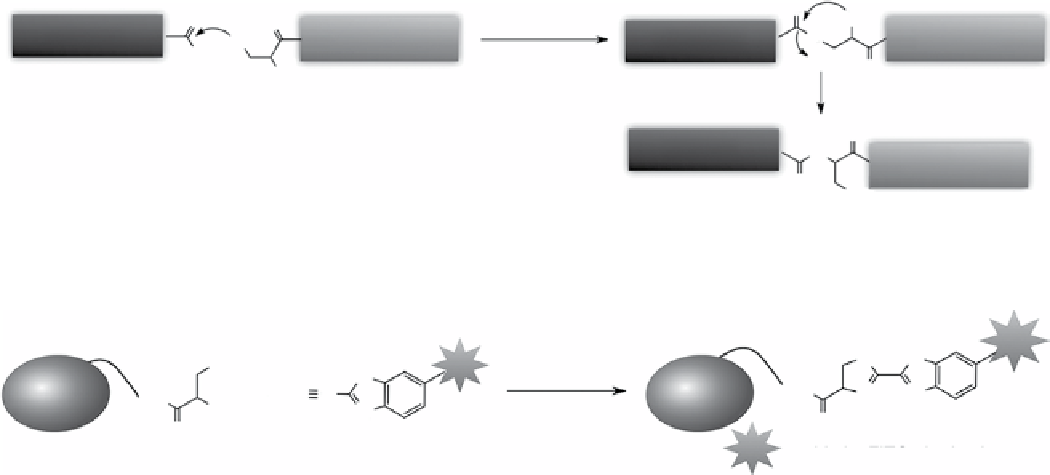Chemistry Reference
In-Depth Information
Chemoselective
reaction
O
O
NH
2
O
peptide 1
peptide 2
S
-
S
peptide 2
peptide 1
SR
+
O
NH
3
Spontaneous
rearrangement
O
N
peptide 1
peptide 2
O
SH
scheme 2.18
native chemical ligation of two peptide fragments.
PBS buffer
pH 7.4
S
S
SH
S
HN
+
NC
N
N
HN
NH
2
Target protein
Target protein
N
O
= Biotin, FITC, rhodamine
O
scheme 2.19
Protein modification using the CbT-cysteine condensation reaction.
alkyl esters, thiol additives are often used to perform
in situ trans
-thioesterification before cysteine is utilised [220]. Addition
of a water-soluble thiol, (4-carboxylmethyl) thiophenol (MPAA), was able to complete the nCL reaction within several
hours [221]. The utility of the nCL to ligate peptide-α-thioester has been expanded from n-terminal cysteine-peptide to
peptides ended with glycine alanine [222], phenyl alanine [223, 224], valine [225], lysine [226], leucine [227], and gluta-
mine [228], all of which require a second step for desulfurisation after the original nCL.
besides its initial application in peptide and protein synthesis [229-231], nCL has become a useful tool in the synthesis
and ligation of peptide nucleic acids [232, 233], preparation of lipid-gFP conjugates [234], construction of glycopeptides
[235], synthesis of peptide or protein dendrimers [236], hydrogel cross-linking [237], construction of protein-based micelles,
and conjugation of peptide to solid supports [239], amongst others [240].
2.3.1.2 CBT Condensation Chemistry
A condensation reaction between d-cysteine and 2-cyanobenzothiazole (CbT)
was first used in the synthesis of d-luciferin, a common firefly luciferase substrate [241]. Rao and co-workers found the
reaction could proceed rapidly under physiological pH conditions in water. This finding led to a new biocompatible conjuga-
tion method (Scheme 2.19) [242]. CbT derivatives only react with 1,2- or 1,3-aminothiol-containing molecules to form
stable condensation products, while reactions with the thiol group alone can only lead to the formation of unstable or revers-
ible products. Therefore, peptide or protein possessing n-terminal cysteine can be modified to introduce various functional-
ities, such as fluorescent molecules, biotin, and F-18 with high selectivity and efficiency (at room temperature within 1
hour). The CbT condensation reaction also allowed successful labelling of cell surface proteins while n-terminal cysteine
residues were present. This efficient conjugation reaction led to self-condensation and assembly of imaging molecules,
which possess both CbT or its analogues and a free cysteine residue on the same molecule, in living cells [243-245].
besides the generation of n-terminal cysteine using recombinant proteins followed by enzymatic cleavage [242], Chin
and co-workers recently reported ways of genetically introducing 1,2-aminothiol for site-specific protein labelling [246],
expanding the utilities of the CbT condensation for site-specific labelling of proteins.
2.3.2
aromatic residues
Modification of native protein residues other than cysteine is less common. The Francis group has developed a few conjugation
protocols for the modification specifically on tyrosine and tryptophan [247]. using the efficient diazonium-phenol coupling
reaction, they were able to modify the tyrosine residues on MS2 virus capsid protein with small functional groups or polymer
selectively with high yields (Scheme 2.20) [248]. Tyrosine residues on proteins were also modified selectively in aqueous media
using a Mannich type reaction [249], via π-allylpalladium complexes [250], or via oxidative modification using cerium(IV)
ammonium nitrate [251].
Methods for selective modification of the tryptophan residue on proteins using rhodium carbenoids at near neutral pHs
were also studied in the Francis group (Scheme 2.21) [252, 253].

